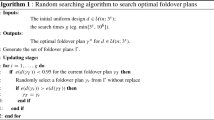Abstract
Although foldover designs can de-alias many effects, they involve at least twice the original number of runs. A semifoldover design, one kind of the partial foldover designs, is typically much more efficient since such a design adds only half of the new runs of a foldover design to the initial design. Semifoldover designs for two-level orthogonal arrays have been investigated in recent literatures. With the use of linear-quadratic system, this paper considers semifoldover designs for three-level orthogonal arrays with quantitative factors. We examine when the linear effects can be de-aliased from their aliased two-factor interactions for regular and nonregular designs, and obtain some good properties via semifolding over on partial factors or all factors. Theoretical properties and some examples are provided to illustrate the usefulness of the proposed designs.



Similar content being viewed by others
References
Ai M, Hickernell FJ, Lin DKJ (2008) Optimal foldover plans for regular \(s\)-level fractional factorial designs. Stat Probab Lett 78:896–903
Balakrishnan N, Yang P (2009) De-aliasing effects using semifoldover techniques. J Stat Plan Inference 139:3102–3111
Barnett J, Czitrom V, John PW, León RV (1997) Using fewer wafers to resolve confounding in screening experiments. In: Czitrom V, Spagon PD (eds) Statistical case studies for industrial process improvement \({\bf V}\). SIAM, Philadelphia, pp. 235–250
Cheng SW, Wu CFJ (2001) Factor screening and response surface exploration. Stat Sin 11:553–580
Cheng SW, Ye KQ (2004) Geometric isomorphism and minimum aberration for factorial designs with quantitative factors. Ann Stat 32:2168–2185
Daniel C (1962) Sequences of fractional replicates in the \(2^{p-q}\) series. J Am Stat Assoc 57:403–429
Drapper NR, Smith H (1998) Applied Regression Analysis. Wiley, New York
Edwards DJ (2011) Optimal semifoldover plans for two-level orthogonal designs. Technometrics 53:274–284
Fontana R, Pistone G, Rogantin MP (2000) Classification of two-level factorial fractions. J Stat Plan Inference 87:149–172
Mee RW, Peralta M (2000) Semifolding \(2^{k-p}\) designs. Technometrics 42:122–134
Ou Z, Qin H, Cai X (2015) Optimal foldover plans of three-level designs with minimum wrap-around \(L_2\)-discrepancy. Sci China Math 58:1537–1548
Pistone G, Wynn HP (1996) Generalised confounding with Gröbner bases. Biometrika 83:653–666
Pang F, Liu MQ (2010) Indicator function based on complex contrasts and its application in general factorial designs. J Stat Plan Inference 140:189–197
Sabbaghi A, Dasgupta T, Wu CFJ (2014) Indicator functions and the algebra of the linear-quadratic parameterization. Biometrika 101:351–363
Wang J, Wu CFJ (1995) A hidden projection property of Plackett–Burman and related designs. Stat Sin 5:235–250
Wu CFJ, Hamada MS (2009) Experiments: planning, analysis, and optimization, 2nd edn. Wiley, New York
Xu H, Cheng SW, Wu CFJ (2004) Optimal projective three-level designs for factor screening and interaction detection. Technometrics 46:280–292
Yang P (2013) Optimal blocking and semifoldover plans for \(2^{n-p}\) designs. Stat Probab Lett 83:624–630
Yang P, Li W (2014) Blocked two-level semifoldover designs. J Stat Plan Inference 144:133–140
Yang P, Lin CY, Li W (2015) Blocked semifoldovers of two-level orthogonal designs. Metrika 78:529–548
Ye KQ (2003) Indicator function and its application in two-level factorial designs. Ann Stat 31:984–994
Ye KQ (2004) A note on regular fractional factorial designs. Stat Sin 14:1069–1074
Acknowledgements
The authors thank Editor Professor Werner G. Müller and two referees for their valuable comments. This work was supported by the National Natural Science Foundation of China (Grant Nos. 11771220, 11701109 and 11861017), National Ten Thousand Talents Program, Tianjin Development Program for Innovation and Entrepreneurship, Sichuan University Post-Doctor Research Project, Guangxi Natural Science Foundation (Grant Nos. 2018JJB110027 and 2018AD19235), and the Ph.D. Candidate Research Innovation Fund of Nankai University. The first three authors contributed equally to this work.
Author information
Authors and Affiliations
Corresponding author
Additional information
Publisher's Note
Springer Nature remains neutral with regard to jurisdictional claims in published maps and institutional affiliations.
Appendix: Proofs
Appendix: Proofs
Proof of Proposition 1
According to the condition in Proposition 1, we have \(\mathcal {F}_{\gamma _5 } =\left( \mathcal {F}^T, \mathcal {F}(3)^T\right) ^T\), where \( \mathcal {F}(3)=(A_1, A_2, A_3 ^{\gamma _5 })\). Then we have
and
Clearly, \(|(\mathcal {F}_{\gamma _5})_{T_1 T_2 L} |=|(\mathcal {F}_{\gamma _5})_{T_1 T_2 Q} |\). From Lemma 1, this completes the proof. \(\square \)
Proof of Theorem 1
Suppose \(\mathbf{w}\) and \(\mathbf{w'}\) are any two generalized words of odd length and even length corresponding to \(b_\mathbf{t} \ne 0\) and \(b_\mathbf{t'} \ne 0\) in \(\mathcal {F}\), respectively. Then \(b_\mathbf{t}\) and \(b_\mathbf{t'}\) in \(\mathcal {F}\) become \(-b_\mathbf{t}\) and \(b_\mathbf{t'}\), respectively, in the full semifoldover plan \(\mathcal {F}({ 1 \ldots k })\). Since the combined design is \(\left( \mathcal {F}^T, \mathcal {F}({ 1 \ldots k })^T\right) ^T,\) we have Theorem 1 immediately. \(\square \)
Proof of Theorem 2
The proof of Theorem 2 is similar to that of Theorem 1, we omit it here for saving space. \(\square \)
Rights and permissions
About this article
Cite this article
Li, W., Guo, B., Huang, H. et al. Semifoldover plans for three-level orthogonal arrays with quantitative factors. Stat Papers 62, 2691–2709 (2021). https://doi.org/10.1007/s00362-020-01211-2
Received:
Revised:
Published:
Issue Date:
DOI: https://doi.org/10.1007/s00362-020-01211-2



